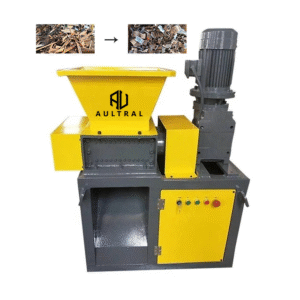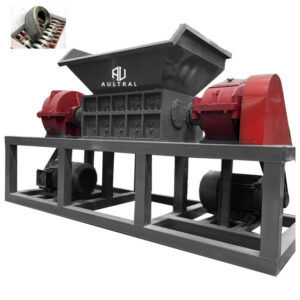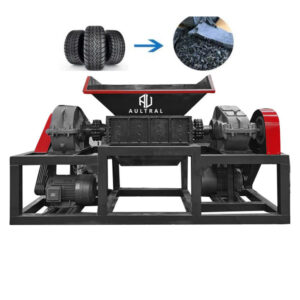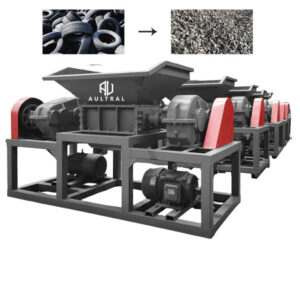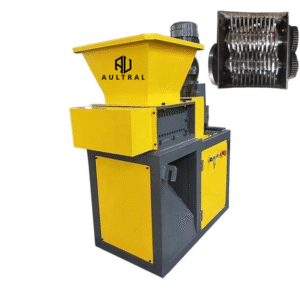1. Working Principle Comparison
Dual-Shaft Shredder
-
Design: Two counter-rotating shafts with interlocking blades create a shearing and tearing action.
-
Power: Hydraulic or high-torque electric drive (55–400 kW).
-
Blades: Replaceable “hook” or “square” blades with customizable tooth profiles.
-
Best for: High-volume processing of tough, bulky, or elastic materials.
Single-Shaft Shredder
-
Design: A single rotating shaft with fixed or replaceable blades uses a ripping and cutting motion.
-
Power: Electric motor (15–110 kW), lower energy consumption.
-
Blades: Helical or hook-shaped blades (often one-piece).
-
Best for: Smaller-scale processing of soft or thin materials.
Table: Key Differences Between Dual-Shaft and Single-Shaft Shredders
| Feature | Dual-Shaft Shredder | Single-Shaft Shredder |
|---|---|---|
| Crushing Force | High shearing force | Moderate tearing force |
| Material Size | Handles large, irregular scrap | Better for pre-cut or small waste |
| Maintenance | Replaceable blade segments | Full blade replacement |
| Noise Level | 80–90 dB (with enclosures) | 70–85 dB |
2. Material-Specific Recommendations
Dual-Shaft Shredder Ideal For:
✅ Hard Metals (e.g., engine blocks, scrap steel) – High torque prevents stalling.
✅ Elastic Materials (e.g., tires, rubber, cables) – Anti-wrapping design.
✅ Bulky Waste (e.g., appliances, demolition debris) – Wide hopper (up to 1500mm).
Single-Shaft Shredder Ideal For:
✅ Soft Plastics (e.g., PET bottles, films) – Gentle shredding prevents melting.
✅ Fibrous Waste (e.g., textiles, paper) – Efficient tearing without clogging.
✅ Thin Metals (e.g., aluminum cans, sheet metal) – Lower energy consumption.
Pro Tip: Test your material’s hardness (Mohs scale), density (kg/m³), and tensile strength before deciding.
3. Key Decision Factors
1. Throughput Requirements
-
Dual-Shaft: Best for >10 tons/hour continuous operation.
-
Single-Shaft: Suitable for <5 tons/hour batch processing.
2. Maintenance & Operating Costs
-
Dual-Shaft:
-
Blade life: 800–1,200 hours (individual teeth replaceable).
-
Higher upfront cost but lower cost per ton in high-volume applications.
-
-
Single-Shaft:
-
Blade life: 1,500+ hours (but requires full blade replacement).
-
Cheaper upfront, ideal for small-scale recyclers.
-
3. Safety & Automation
-
Dual-Shaft:
-
Auto-reverse function prevents jams.
-
IoT-enabled models offer real-time monitoring.
-
-
Single-Shaft:
-
Mechanical emergency stop (slower response).
-
Simpler operation for low-risk materials.
-
4. Real-World Case Studies
Case 1: Scrap Metal Processor
-
Problem: Single-shaft shredder struggled with car engines (frequent jams).
-
Solution: Upgraded to dual-shaft shredder with hydraulic pusher.
-
Result:
-
70% fewer breakdowns.
-
Output increased from 3 t/h to 7 t/h.
-
Case 2: Plastic Recycling Plant
-
Problem: Dual-shaft shredder over-processed PP granules.
-
Solution: Switched to single-shaft granulator (adjusted screen size).
-
Result:
-
Energy savings: 40%.
-
Material consistency: >98% uniform granules.
-
5. Interactive Tools for Buyers
-
Shredder Selector Tool: Upload material photos → Get machine recommendations.
-
TCO Calculator: Compare 5-year costs (purchase + maintenance + energy).
6. Common Myths Debunked
❌ “More power = better performance” → Oversized shredders waste energy.
❌ “Dual-shaft is always more expensive” → Long-term ROI may be better.
Conclusion: How to Choose
-
For heavy-duty scrap: Dual-shaft shredders deliver higher efficiency.
-
For light, uniform waste: Single-shaft shredders save costs.

